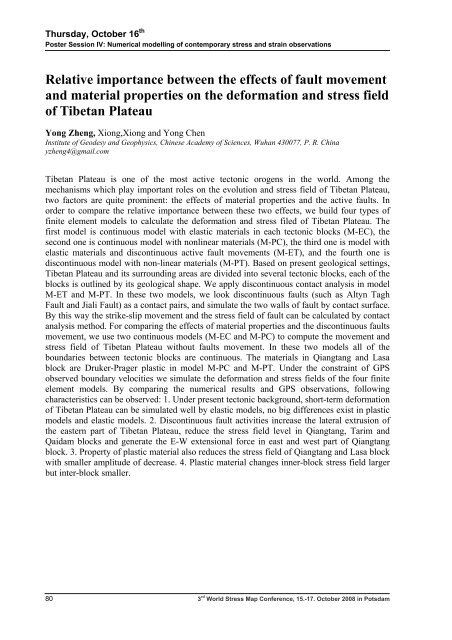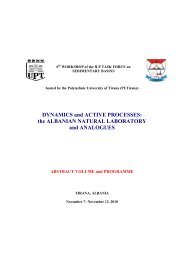World Stress Map Conference - International Lithosphere Program ...
World Stress Map Conference - International Lithosphere Program ...
World Stress Map Conference - International Lithosphere Program ...
Create successful ePaper yourself
Turn your PDF publications into a flip-book with our unique Google optimized e-Paper software.
Thursday, October 16 th<br />
Poster Session IV: Numerical modelling of contemporary stress and strain observations<br />
Relative importance between the effects of fault movement<br />
and material properties on the deformation and stress field<br />
of Tibetan Plateau<br />
Yong Zheng, Xiong,Xiong and Yong Chen<br />
Institute of Geodesy and Geophysics, Chinese Academy of Sciences, Wuhan 430077, P. R. China<br />
yzheng4@gmail.com<br />
Tibetan Plateau is one of the most active tectonic orogens in the world. Among the<br />
mechanisms which play important roles on the evolution and stress field of Tibetan Plateau,<br />
two factors are quite prominent: the effects of material properties and the active faults. In<br />
order to compare the relative importance between these two effects, we build four types of<br />
finite element models to calculate the deformation and stress filed of Tibetan Plateau. The<br />
first model is continuous model with elastic materials in each tectonic blocks (M-EC), the<br />
second one is continuous model with nonlinear materials (M-PC), the third one is model with<br />
elastic materials and discontinuous active fault movements (M-ET), and the fourth one is<br />
discontinuous model with non-linear materials (M-PT). Based on present geological settings,<br />
Tibetan Plateau and its surrounding areas are divided into several tectonic blocks, each of the<br />
blocks is outlined by its geological shape. We apply discontinuous contact analysis in model<br />
M-ET and M-PT. In these two models, we look discontinuous faults (such as Altyn Tagh<br />
Fault and Jiali Fault) as a contact pairs, and simulate the two walls of fault by contact surface.<br />
By this way the strike-slip movement and the stress field of fault can be calculated by contact<br />
analysis method. For comparing the effects of material properties and the discontinuous faults<br />
movement, we use two continuous models (M-EC and M-PC) to compute the movement and<br />
stress field of Tibetan Plateau without faults movement. In these two models all of the<br />
boundaries between tectonic blocks are continuous. The materials in Qiangtang and Lasa<br />
block are Druker-Prager plastic in model M-PC and M-PT. Under the constraint of GPS<br />
observed boundary velocities we simulate the deformation and stress fields of the four finite<br />
element models. By comparing the numerical results and GPS observations, following<br />
characteristics can be observed: 1. Under present tectonic background, short-term deformation<br />
of Tibetan Plateau can be simulated well by elastic models, no big differences exist in plastic<br />
models and elastic models. 2. Discontinuous fault activities increase the lateral extrusion of<br />
the eastern part of Tibetan Plateau, reduce the stress field level in Qiangtang, Tarim and<br />
Qaidam blocks and generate the E-W extensional force in east and west part of Qiangtang<br />
block. 3. Property of plastic material also reduces the stress field of Qiangtang and Lasa block<br />
with smaller amplitude of decrease. 4. Plastic material changes inner-block stress field larger<br />
but inter-block smaller.<br />
80 3 rd <strong>World</strong> <strong>Stress</strong> <strong>Map</strong> <strong>Conference</strong>, 15.-17. October 2008 in Potsdam




